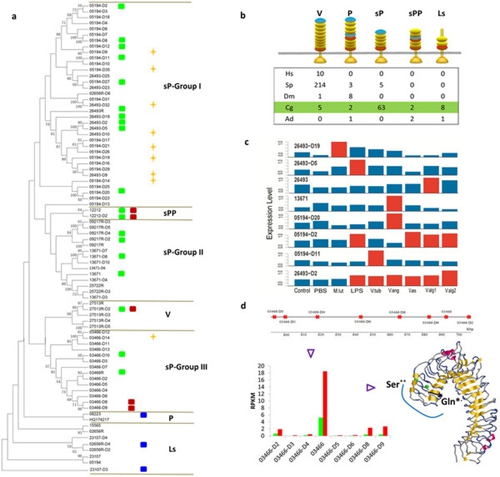中国科学院海洋研究所研究员张国范团队与美国新泽西州立大学教授郭希明、佛罗里达大学教授Gary Litman合作,在长牡蛎免疫相关基因的进化和功能分化研究方面取得新进展。
该研究发现,牡蛎免疫基因除高度扩张外,更为有趣的是多个基因家族以及家族中的不同成员均在病原和非病原类胁迫防御中发挥着重要作用,其中一些基因还参与了发育调控、组织分化等生物学过程。这项研究表明牡蛎天然免疫基因通过串联重复基因的功能分化形成了一个复杂有效的调控网络,也说明了免疫和胁迫抗性基因的一致性适应性进化起源古老。
牡蛎是一类重要的经济贝类,也是潮间带生态系统的关键种,其独特的生活环境和生物学特征为研究无脊椎动物对逆境适应提供了极好的模型。这是张国范团队继牡蛎非生物逆境适应组学机制Nature论文发表之后,牡蛎天然免疫进化又一突破性研究进展,为全面揭示牡蛎潮间带适应以及海洋生物进化具有重要推动作用。
相关成果在线发表在Scientific Reports 杂志上,第一作者为张琳琳。

牡蛎Toll-like受体的基因复制及功能分化
原文链接:Massive expansion and functional divergence of innate immune genes in a protostome
The molecules that mediate innate immunity are encoded by relatively few genes and exhibit broad specificity. Detailed annotation of the Pacific oyster (Crassostrea gigas) genome, a protostome invertebrate, reveals large-scale duplication and divergence of multigene families encoding molecules that effect innate immunity. Transcriptome analyses indicate dynamic and orchestrated specific expression of numerous innate immune genes in response to experimental challenge with pathogens, including bacteria, and a pathogenic virus. Variable expression of individual members of the multigene families encoding these genes also occurs during different types of abiotic stress (environmentally-equivalent conditions of temperature, salinity and desiccation). Multiple families of immune genes are responsive in concert to certain biotic and abiotic challenges. Individual members of expanded families of immune genes are differentially expressed under both biotic challenge and abiotic stress conditions. Members of the same families of innate immune molecules also are transcribed in developmental stage- and tissue-specific manners. An integrated, highly complex innate immune system that exhibits remarkable discriminatory properties and responses to different pathogens as well as environmental stress has arisen through the adaptive recruitment of tandem duplicated genes. The co-adaptive evolution of stress and innate immune responses appears to have an ancient origin in phylogeny.

